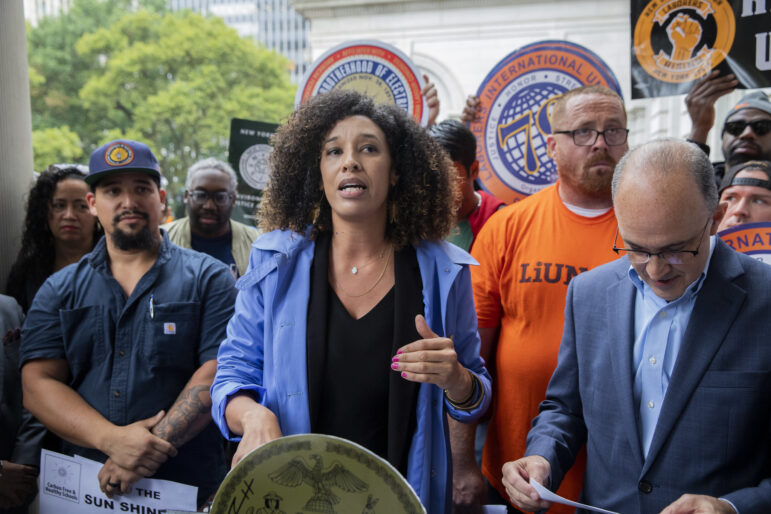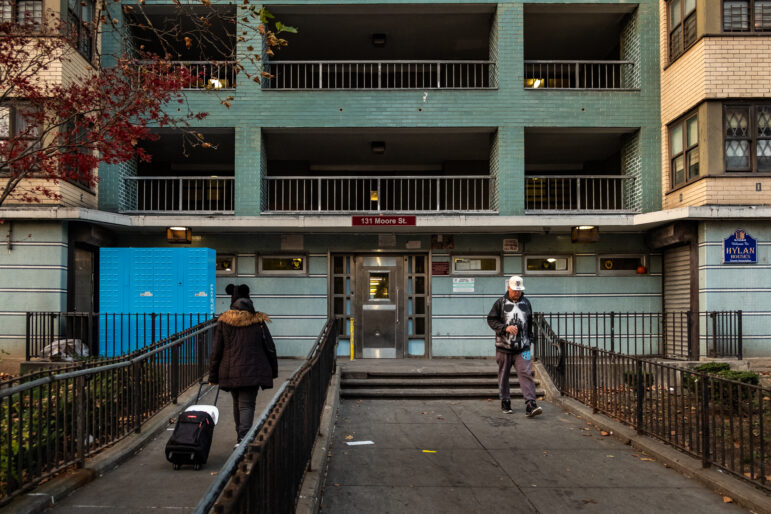In the summer of 1998, more than 2,000 property owners in Bedford-Stuyvesant, each at least three years behind on their property taxes, got a nasty reminder of their predicament: a letter saying the city would soon sell their tax debt to a private collection agency. If they didn’t pay off their debts, the clock to foreclosure would start ticking.
Homeowners’ panic intensified when the Daily News published a lengthy list of tax-delinquent properties–including their homes. Deluged by their nervous phone calls, local city councilmember Annette Robinson hosted a community meeting, which drew about 600 people.
“It had put a real scare in a lot of Bed-Stuy homeowners,” remembers Deb Howard, director of homeowner services with the Pratt Area Community Council, who was at the meeting. “There were a lot of senior homeowners there. A lot of widows there.”
City officials tried to calm attendees, assuring them that they wouldn’t immediately lose their homes. They had several weeks to pay back the city so that their tax debt, called a lien, wouldn’t be sold. Even if the lien were sold, they would still have a year or more to pay back the collection agency. But if they couldn’t come up with the cash eventually, officials did warn, the foreclosure process would begin.
How could these homeowners get cash in time? The vast majority of attendees had built up a tax debt because their monthly incomes weren’t enough to pay everything. Or they’d been hit by a financial emergency, like medical bills. Extra resources to pay thousands of dollars in tax debts didn’t exist.
The answer, it turned out, was waiting for them just out the front doors when the meeting ended. “Right outside, there must have been 30 guys with quick-cash flyers waiting,” remembers Howard. “It was like the sharks surrounding the fish.”
The men were representatives of mortgage companies that specialize in loaning money to low-income homeowners. Through a dizzying array of added fees, high interest rates and hidden payments–practices that add up to the phenomenon known as predatory lending–many of these brokers profit by taking advantage of desperate consumers. Homeowners facing the loss of their homes through an unyielding process like tax lien sales are the perfect mark.
_______
The city began its tax lien sales program in 1996, as a way to avoid the time-consuming process of collecting debt and the expensive route of taking over and running the properties of owners who just won’t, or can’t, pay up. The city now pools together all the unpaid liens, and sells the debt to a private trust. The trust’s investors don’t actually buy the liens themselves. They buy bonds, which are paid back with interest as the debts are collected. And “tax liens” doesn’t fully describe the effort’s scope; the liens include not only back property taxes but unpaid water and sewer bills as well as charges for emergency sidewalk cleaning, boiler repair and other city services.
The city and the private collection agency have only one mandate–getting the money as soon as possible. They’ve met that goal: Since 1996, most liens have been paid off. “The program’s been so successful,” says John Chilson, the managing director of JER Revenue Services, the collection agency, in a recent interview. “No one took us seriously at first, but now we can tell they appreciate the sense of urgency.” This innovative approach–to this day, no other city in the world has a program that rivals the size or scope of New York’s–has been a fiscal success, raising more than $895 million in the past six years.
But this huge enterprise has been anything but a boon for low-income homeowners. The city’s new debt collection system treats all property owners the same–it’s pay up, or face a foreclosure auction. As a way out, the evidence suggests, the poorest property owners have sought quick cash.
“You have to ask who’s won and who’s lost,” says Sarah Ludwig, executive director of the Neighborhood Economic Development Advocacy Project. “A lot of money has been made through the securitization, but that doesn’t help little old ladies. The city has to examine the public policy implication for this program on low-income seniors.”
Among the 31,000 liens sold, approximately 7,500 come from small homes, each with one to four families living in them. One of those occupants is usually the owner. Their debts usually range from just several thousand dollars to as much as $25,000. For these thousands of homeowners, from Bushwick to Jamaica to Cypress Hills and beyond, tax lien sales have provided a shock just like the one that scared those Bed-Stuy residents.
Homeowner counselors in those neighborhoods says that increasingly, the fear of tax foreclosure is driving many of their clients to consider increasing their indebtedness, no matter what the terms. Already, the number of borrowers more than three months behind on their Federal Housing Administration mortgages–federally guaranteed loans targeted at middle- and low-income buyers–rose more than 30 percent last year to 10 percent of all mortgages in New York City, the highest rate in the nation. Last year, the city also saw a 10 percent jump in the number of foreclosure proceedings initiated. In that light, homeowners’ actions in the face of tax lien troubles concern counselors. “People are using their home’s equity to pay off their tax debts,” observes Herman de Jesus, a community organizer and homeowner counselor for the Cypress Hill Development Corporation. “It’s the quickest way to get money, but they’re jeopardizing their homes.”
As she counsels homeowners during her work as an attorney with Legal Services for the Elderly in Queens, Kim Madden has seen her clients fall behind on their property taxes for many reasons. One senior citizen client had been in and out of the hospital for years, and couldn’t pay a $5,000 tax lien. Another client was disoriented by Alzheimer’s, and just ignored her tax bills. “These are seniors who have lived in their homes for 40 or 50 years,” observes Madden.
There’s another reason, counselors say, that homeowners can end up behind on their taxes: They don’t know they’re supposed to pay them. That’s what happened to Margaret Bailey. The widow had paid off her mortgage in the early 1990s, and, because most mortgages include automatic tax payments, she then mistakenly believed that she didn’t need to start paying taxes. As she stretched her budget thin helping her grandchildren attend college, the St. Albans resident ignored tax bills that began to arrive. By the time she realized she needed to pay, a lien on her home was sold, in 1998, for about $22,000. “Boy, that high interest really got everything terribly out of place,” says Bailey, who gives her age as “over 80.”
Bailey realized that she needed to get together the cash or she would lose her home. During this time, she says several aggressive lenders approached her: “Some crooked guys tried to lead me down the primrose path,” Bailey remembers. “They saw an old lady they could scam.” The senior slammed the door on the lenders because she knew to avoid predatory loans from volunteering with a local community organization. Instead, she decided to cash some stock she owned: “It was my retirement money,” she says ruefully. “But I couldn’t lose my home, or I’d be a bag lady. What, am I going to live in some SRO?”
Any small slip-up in tax payments can become a big problem quickly. On a modest two-family house in a poor neighborhood, property taxes are about $1,200 to $1,500 per year. But the city’s 18 percent interest, compounded daily, causes tax debt to balloon quickly if unpaid–three years of unpaid $1,500 tax bills, for example, grow to $6,519.
_______
The city’s first tax lien sales, in 1996, didn’t touch homeowners. Nearly 4,500 liens were sold, but all were either from apartment buildings, commercial properties or vacant lots. With housing advocates and City Council members skeptical of these new market-based tax collection strategies, city officials were better off without stories of homeowners being booted. “They didn’t want to put little old ladies out of their houses,” says one knowledgeable observer of the tax lien sales process. “Who knows if it was good policy or just public relations?”
The city stressed in the early stages of the tax lien sales program that the impact on residential properties would be minimal. The city department of Housing Preservation and Development would develop an “early warning” system to make sure that vulnerable properties were excluded from the process.
Despite these assurances, 2,356 liens were sold on one- to four-family homes the following year. Thousands more would follow in subsequent years. The city and JER have run eight tax lien sales, each of which involves hundreds of properties, since 1996.
At least two months before each sale, the city compiles a list of those homes with at least three years’ worth of debt (as opposed to one year for larger apartment buildings or commercial properties). When the liens are sold, JER, a multibillion-dollar company specializing in managing troubled assets for government and private industry, takes over debt collection. The company is paid through a 5 percent fee added when a lien is sold.
JER first tries to convince a homeowner to pay at least the first six months of interest on their lien. If there is no payment or effort to set up a short-term installment plan in the first six months, the foreclosure process begins. That process lasts anywhere from one year to several, culminating in a court-supervised property auction.
With that long timeline, the ultimate consequence of many of the roughly 7,500 liens sold on homes since 1996 is unknown. But one thing is certain: Few properties have actually been auctioned, just 24 homes, according to JER. On the remainder of the properties, about 40 percent of the liens had been paid off as of August of last year, according to numbers compiled by the City Council. The remaining 59 percent were classified as “in collection,” meaning that either the debt is being paid off, or the foreclosure process is ongoing or may soon begin.
Even when the homeowners are able to make the payments, troubling questions abound. No one knows how many took out high-interest loans to pay off their liens, or how many of the thousands of liens still in collection could ultimately end up in foreclosure.
What is clear is which neighborhoods will live with the results of the city’s initiative. If housing advocates’ suspicions are correct, and the tax lien sales squeeze is pushing homeowners to take out predatory loans, the consequences could be apparent only years from now, with a wave of foreclosures in low-income neighborhoods.
The Neighborhood Economic Development Advocacy Project has mapped where homes have had liens that had entered into the foreclosure process. “There’s an overwhelming concentration of tax liens in poor minority neighborhoods,” observes Ludwig. “And they’re the same neighborhoods where we see predatory loans flourish.”
_______
Predatory lending is just the ugly corner of a huge market in lending to borrowers with less-than-perfect credit; what the industry calls sub prime lending. From 1993 to 1998, the number of sub-prime home loans grew by 760 percent, compared with a 38 percent jump in regular home loans. Predatory loans are sub-prime loans with particularly high interest rates, hidden fees and unnecessary charges that maximize profits for the lending companies while swelling the loan payments of the borrower.
Taking out predatory mortgages is often the death knell for struggling homeowners. The financial difficulties that led them to sub-prime loans in the first place do not go away, and the loan brings unnecessarily high mortgage payments, crippling their budgets. Many mortgage-holders miss payments within just a few months, leading to the beginning of foreclosure.
The mortgage lending industry contends that predatory loans are an exaggerated problem, sold only by renegade street-level brokers. That claim was significantly undermined earlier this year, however, when an assistant branch manager who worked for Citigroups’s subprime division for more than five years filed a sworn affidavit in federal court. Gail Kubiniec’s testimony detailed exactly how her firm sought to add as many fees as possible to each loan, regardless of the borrower’s ability to pay back: “I and other employees would often determine how much insurance could be sold to a borrower based on the borrower’s occupation, race, age, and education level. If someone appeared uneducated, inarticulate, was a minority, or was particularly old or young, I would try to include all the coverages CitiFinancial offered.”
Those salesmen waiting outside the Bed-Stuy information meeting were engaging in the classic predatory lending marketing technique: identifying and targeting low-income homeowners who desperately need cash. Advocates who counsel homeowners with tax liens tell of numerous other tactics, not just blanketing homeowners with mailings, phone calls and aggressive door-to-door sales, but also offers of premium gifts: Get a free color TV at the closing of your new mortgage!
What makes tax lien sales ripe territory for unscrupulous lenders is that this little-known program is actually very public. Aggressive lenders already make a habit of tracking published lists of foreclosures as a source for customers. Now, they do the same with tax lien sales. When the city prepares to sell unpaid tax liens to JER, a list of every property owing back taxes is published in the Daily News, and several ethnic newspapers, not once, but twice. That list is also downloadable from the city Department of Finance web site. Once JER initiates the foreclosure process, the action shows up on public real estate databases. “At every step in tax lien sales,” concludes Eduardo Canedo, until recently on staff at the Foreclosure Prevention Project at South Brooklyn Legal Services, “unscrupulous lenders are informed of a great opportunity to take advantage of homeowners in financial trouble.”
_______
The inflammatory combination of homeowners desperate to raise cash to pay off tax debts and a flourishing industry that feeds off those fears has seemingly gone unnoticed by those who run the tax lien sales program. When questions are raised to the Department of Finance, which administers tax collection, they respond by pointing proudly to the informational office they’ve set up, called the tax lien sales ombudsman, and their willingness to set up payment plans with indebted homeowners. However, those mechanisms have proven to be woefully inadequate.
Last year, the tax lien ombudsman received 28,651 inquiries, 12,279 of which came from senior citizens. The power of the ombudsman’s office, however, is very limited–its main role is to make sure the taxpayer understands the process. At most, they fix problems on the rare occasions that a property owner is incorrectly billed. They can set up payment plans, but those typically cover a year or two, rarely enough time for a cash-poor homeowner to pay off thousands in debt. They can’t negotiate how much is owed, or even their interest rate.
“Their program doesn’t help anyone I’ve ever come across, because my homeowners can’t pay that large a payment,” says Storm Russell, the director of Jamaica Housing Improvement, Inc., which counsels and helps organize homeowners and tenants. “If they did have that kind of money, they wouldn’t have fallen behind on their taxes in the first place.”
Others have been less than impressed by Finance’s ability to provide homeowners with the information they need to make sound financial decisions. Madden tells of one desperate client who owed JER thousands of dollars, and who was on the verge of losing her home to foreclosure. In the several years since the first lien was sold, she had also accumulated thousands more in unpaid tax bills. The woman went to Finance, which urged her to pay the new tax bill–presumably the only debt of hers listed in the agency’s computers. The woman had a small savings, and she almost used it to pay the newer debt. Madden was able to stop her, and convince her to use her few resources to pay off the older debt, the JER lien, to avoid foreclosure. She still can’t believe that Finance didn’t realize that the woman was on the verge of losing her home. “The city didn’t even know the other lien had been sold,” says Madden. “She would have paid a bill and still lost her house.”
Similarly, JER has little in place for homeowners with trouble paying back their debt. They too tout their informational and payment plans, but, again, there’s no negotiating the amount of debt. (JER will do installment plans for up to three years, but most are shorter.) JER stresses that because it is contractually obligated to the city to collect the debts, it can’t be more flexible. Still, many homeowners try to negotiate. “They often want to,” said Chilson. “There’s a lot of gamesmanship, a lot of people trying to play the system.”
Madden says she’s found it harder to talk to JER on behalf of her clients than it is to negotiate with predatory lenders. “The servicer is very inflexible,” she says. “They really generally don’t see any point in negotiating. It’s hard for me as an attorney to even know what to say to them. At least with predatory lenders, they’re afraid of lawsuits and bad publicity.”
With little flexibility from the debt collectors, even small lien amounts can be devastating. Last year, de Jesus with the Cypress Hill Development Corporation had a visit from a senior citizen client who had a $6,000 tax lien that was about to be sold to JER. The client had paid off his mortgage, but lived on only $200 a month, so he couldn’t afford his tax bill. “They could have foreclosed on the $200,000 property to get just $6,000 back,” remembers de Jesus. “Luckily, we were able to get him a loan through the Parodneck Foundation,” which, with support from HPD, helps bail out certain homeowners.
In theory, the most vulnerable housing properties aren’t even supposed to be in the tax lien sales program. HPD pays neighborhood groups to keep track of troubled properties in their communities, including examining the condition of buildings that face tax lien sales, to help the city decide whether the property should be pulled out of the lien-sale list. One of those groups is Jamaica Housing Improvement, Inc. Russell commends the city agency for the level of scrutiny they apply to the troubled buildings–“They’re very much concerned with how we’re rating the properties. They are interested in any suggestions we can give them to make their program better.”
However, Russell and participants from other neighborhood groups are less impressed with what HPD does next. The agency claims that for excluded properties, it develops a treatment plan, including homeowner counseling, technical assistance and loans. “HPD is supposed to develop a treatment plan, but I’ve never seen one,” says Russell, whose group counsels about 200 distressed homeowners each year. “Sometimes I’m not even sure why we do the surveys. I have no idea whether it helps the homeowner.”
_______
It may take years to figure out if tax lien sales can be an effective fiscal policy without unnecessarily harming residents of poor neighborhoods. But, even now, homeowner counselors and housing advocates say, the city could take some simple steps to protect vulnerable homeowners.
For one thing, the city could extend a program, called the Senior Citizen Homeowners Exemption (SCHE), which gives a reduction in taxes for low-income homeowners over 65. For someone with an income below $19,500, the program offers a 50 percent reduction; for those between $19,500 and $28,900, smaller discounts apply, on a sliding scale.
Counselors say SCHE is an effective tool to keep elderly people in their homes. Still, it has one huge shortcoming: It’s not retroactive. If a senior doesn’t apply for the exemption until she’s 70, but owes a tax lien based upon payments she couldn’t make since she was 65, she has no recourse but to pay the full debt, or lose her home.
They also say the city could do a better job of educating homeowners, particular seniors, many of whom struggle with illiteracy, poor health and, sometimes, dementia. Experts who work with seniors say that repeating straightforward messages is essential. Why not begin explaining tax lien sales as soon as certain homeowners miss their first payment, instead of waiting until their three years are nearly up? Why isn’t the SCHE exemption pushed harder? “They need to explain the tax process a lot better,” says Marcia Vacacela, director of homeowner services for Neighborhood Housing Services. “By the time homeowners hear about the liens, the debt is already so high, it’s too difficult to fix the problem.”
The most controversial proposal, backed by a coalition of legal, counseling and economic organizations called the Tax Liens Monitoring Group, would be to exempt certain categories of homeowners from property taxes. At the very least, the city could allow those groups flexibility in establishing long-term, low-interest payment plans. There is nothing legally preventing the city from excluding these groups now; Finance has full discretion over which liens go in a sale. New York could join Atlanta, which in 1994 excluded lien sales for “those private properties owned by the elderly, handicapped or disadvantaged.” Philadelphia has similar provisions.
Advocates argue that such exclusions are good policy, particularly because many of the liens are for less than $10,000. “They’re making a relatively small amount of money from small homeowners,” argues Canedo. “Losing their houses over a few thousand dollars isn’t worth it.”
But others, like Larian Angelo, deputy director of the City Council’s finance division, argue that exempting certain groups would set a bad precedent, possibly jeopardizing tax collections and budgets. “There has to be some threat involved in paying the taxes,” says Angelo.
_______
What’s so tricky about evaluating tax lien sales is that it’s like a Hepatitis C outbreak–it takes a long time to see the full consequences. If hundreds or thousands of homeowners have been pushed into predatory loans in order to pay off their tax debts, it would take months or years before significant numbers of those homeowners fall behind on their mortgage payments. And then there’s the two- to three-year average length of the tortuous foreclosure process.
What’s worrisome about that possibility is that the victims of predatory lending fueled by tax lien sales are poor neighborhoods’ most valuable asset–long-term homeowners. “Older homeowners are active in block associations,” observes Howard. “They have a history in the neighborhood. They’re very connected. When you have a high turnover in a neighborhood like Bed-Stuy, you see the face of predatory lending in crumbling blocks.”
It’s not just the loss of the family that leaves a foreclosed house behind that hurts neighborhoods. “This is what makes the whole market for real estate speculators,” observes Madden. “They go out, flip the houses and try to get rich. So you move from a home building family equity to feeding speculation. It’s how money gets sucked out of minority neighborhoods–and that creates anger and distrust. It’s so disheartening.”








